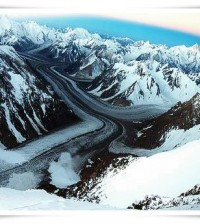- 7000 Plus Meter PeaksPosted 4 years ago
- Deosai Plateau TourPosted 4 years ago
8000 Plus Meter Peaks
K2 8611m, (Savage Mountain / Chogori) Second Highest Peak in the World
K2 is the second-highest mountain on Earth after Mount Everest. With a peak elevation of 8,611 metres (28,251 ft), K2 is part of the Karakoram Range, and is located on the border between the Taxkorgan Tajik Autonomous County of Xinjiang, China, and Skardu, in Gilgit-Baltistan Provience of Pakistan.
K2 is a rocky mountain up to 6,000m, beyond which it becomes an ocean of snow. The traditional route to K2’s base camp goes from Skardu, which is linked with Islamabad by a good road. From Skardu the route goes via Shigar-Dassu-Askole up to Concordia over the Baltoro glacier.
K2 was firstly discovered and measured by the Survey of India in 1856, and first named for English topographer Henry Godwin – Austen, who explored and surveyed the region.
K2 is taken from the first letter of Karakoram, and the number indicates that it was the second peak in the range to be measured. K2 was firstly climbed on July,31 1954 by Italian climbers team lead by Ardito Desio and accompanying him were Lino Lacedelli and Achille Compagnoni. A March 1987 measurement of K2 indicated that it might be higher than Everest, but later that year, Everest was re-measured by a similar method and found to indeed be 778 ft (237m) taller.
Nanga Parbat 8125m, (Killer Mountain)
Nanga Parbat is the second highest mountain in Pakistan, ninth highest mountain on Earth and among the eight-thousanders, it is the largest single mountain.
Nanga Parbat translates to “Naked Mountain” in English; Parbat deriving from the Sanskrit word parvata meaning “mountain, rock”, and nanga an Urdu word meaning “naked”.
Known as the “Killer Mountain”, Nanga Parbat was one of the deadliest of the eight-thousanders for climbers in the first half of the twentieth century; since that time it has been less so, though still an extremely serious climb. It is also an immense, dramatic peak that rises far above its surrounding terrain.
Gasherbrum-I 8068m, (Hidden Peak)
Gasherbrum I (also known as Hidden Peak or K5) is the 11th highest peak on Earth, located on the Pakistan-China border in Gilgit-Baltistan region of Pakistan. Gasherbrum I is part of the Gasherbrum massif, located in the Karakoram region of the Himalaya. Gasherbrum is often claimed to mean “Shining Wall”, presumably a reference to the highly visible face of the neighboring peak Gasherbrum IV; but in fact it comes from “rgasha” (beautiful) + “brum” (mountain) in Balti, hence it actually means “beautiful mountain.”
Gasherbrum I was designated K5 (meaning the 5th peak of the Karakoram) by T.G. Montgomery in 1856 when he first spotted the peaks of the Karakoram from more than 200 km away during the Great Trigonometric Survey of India. In 1892, William Martin Conway provided the alternate name, Hidden Peak, in reference to its extreme remoteness.
Gasherbrum-I was first climbed on July 5, 1958 by Pete Schoening and Andy Kauffman of an eight-man American expedition led by Nicholas B. Clinch. Richard K. Irvin, Tom Nevison, Tom McCormack, Bob Swift and Gil Roberts were also members of the team.
Broad Peak 8047m, (Falchan Kangri)
Broad Peak (originally named K3), known locally as Falchan Kangri , is the 12th highest mountain on Earth, with an elevation of 8047 meters.
Broad Peak is part of the Gasherbrum massif on the border of Pakistan and China.
It is located about 8 kilometres (5 miles) from K2. Broad Peak was originally named K3 right after the naming of K2 but on closer inspection by a later party, it was discovered that the summit was over 1.5 kilometres (1 mile) long, thus “Broad Peak.
Gasherbrum II (also known as K4) is the 13th highest mountain on Earth, located in the Gilgit Baltistan province, Pakistan near the border to China.
Gasherbrum II is the third highest peak of the Gasherbrum massif, located in the Karakoram range of the Himalaya.
The standard route is via the SW ridge as it is relatively free of objective hazards such as ice falls and avalanches.
Gasherbrum II was first climbed on July 8, 1956 by Fritz Moravec, Josef Larch and Hans Willenpart of an Austrian expedition.



You must be logged in to post a comment Login